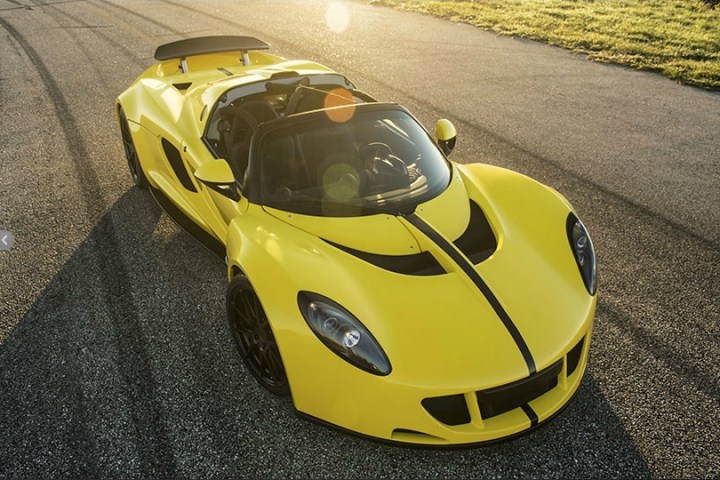
Carmakers love to show off at SEMA. And why not? Last year, the trade show attracted over 60,000 international and domestic buyers. It takes a lot to impress this bunch, so this year Hennessey Performance Engineering (HPE) is pulling out all the stops.
The Venom GT has belonged to top speed royalty since its inception. In February this year, it hit 270.4 mph at NASA’s Kennedy Space Center in Florida — but due to a few factors, that just wasn’t enough.
To be officially recognized by the Guinness Book of World Records as the world’s fastest production car, a vehicle must make one run in each direction to compensate for wind. And to be classified as a “production” vehicle, a company must build 30 or more units. NASA allowed only one run on its 3.2-mile shuttle airstrip, and John Hennessey himself told Top Gear that the company will build only 29 Venom GTs. So though it exceeded the Bugatti Veyron Super Sport’s 267.857 mph run, it didn’t take the top spot. Boo.
Still, numbers don’t lie, and while the 270-mph Venom had to make do with 1,244 hp, the one coming to SEMA bumps it up to 1,451. With E85 Flexfuel running through its veins, the torque in this Venom Spyder’s 7.0-liter V8 increases as well, and boost pressure goes up from 19 to 26 psi. Projected performance shows that it will hit 60 from a standstill in 2.4 seconds, and 100 mph in 4.4 seconds. The quarter mile arrives in 9.7 seconds at 167 mph. Curb weight is just 2,743 lbs.
“Being the fastest matters,” said company founder and president, John Hennessey. “We are intent on keeping the Venom as the fastest, best performing and most exciting hypercar on the road.” He goes on to say that the company will only produce a handful of Venom GTs in 2016, while it works on the upcoming Venom F5.

Hot on the Venom GTs heels is the HPE750 Supercharged Ford Mustang Convertible. Hennessey says that this topless beast will do 0-60 mph in 3.2 seconds. Its 5.0-liter V8 puts out 774 hp, and the supercharger produces 9 psi of boost. It is the first and only 2015 Mustang to hit a verified top speed of 200 mph. One example ran 207.9 mph on Jay Leno’s Garage.
Hennessey has added a carbon fiber splitter, side sills, rear lip spoiler, and lightweight wheels. Brembo racing brakes all around complete the package.

Curb your excitement about the 2017 Raptor, because Hennessey is going all Jurassic Park on it with a VelociRaptor 650 Supercharged Ford F-150. 650 horses propel this big pickup to 60 in 4.9 seconds on 7 lbs. of boost. Performance is further enhanced by Fox suspension and Hennessey wheel and tire upgrades. The bumpers, fender flares, and skid plates have all been replaced with custom parts.
HPE will unveil the yellow trifecta on Tuesday, November 3.


